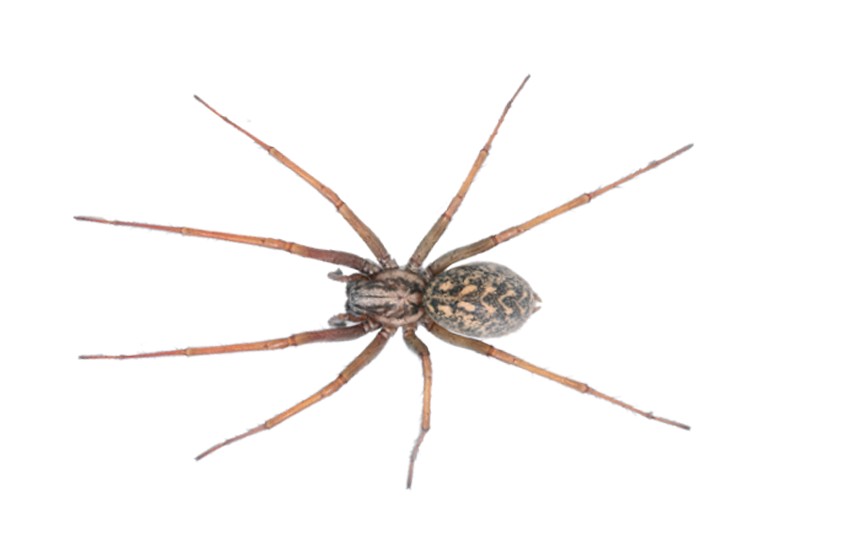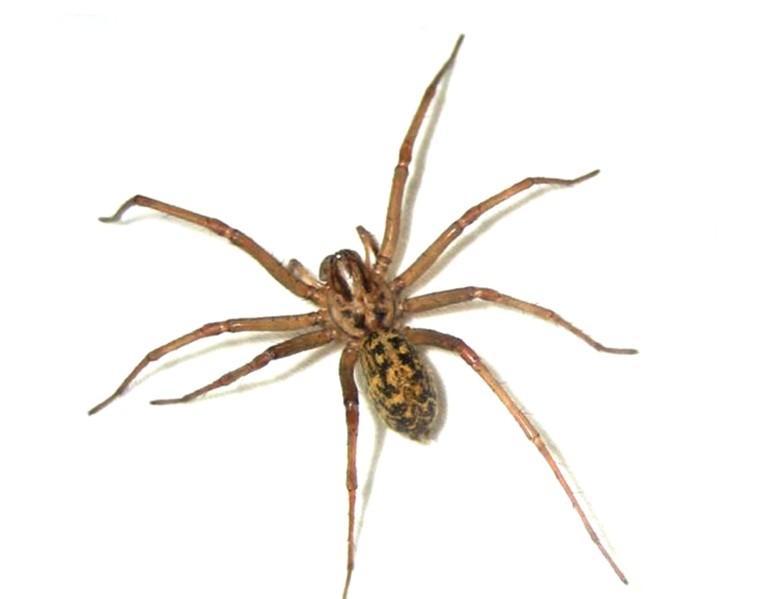Hobo Spider

Picture of a hobo spider
What is a Hobo Spider?
Who agrees Spiders have the superpower to freak us out no matter when and where we spot them? Especially when they’re the big ones? Phew! Hobo spiders fall in the same category of scaring the wits out of you merely by their appearance. Hey, who are these spiders?
Hobo Spiders, also called ‘funnel-web spiders’ are native to Europe, and they’re mostly confused with the Australian funnel-web spiders. Do not mix the two up cause they’re different. The ‘Hobos’ were first introduced in Pacific Northwest region decades ago in 1930 and have since then spread across to almost six other states, kind of expanding their territory!
Size and Appearance
 Let us be honest, for correctly identifying a spider species you need to be an arachnologist – someone who studies spiders. This is because you need to examine them with the help of the microscope to identify their reproductive organs rightly. Hobo spiders have a similar appearance to that of other spiders, and it is difficult to spot them just by how they look.
Let us be honest, for correctly identifying a spider species you need to be an arachnologist – someone who studies spiders. This is because you need to examine them with the help of the microscope to identify their reproductive organs rightly. Hobo spiders have a similar appearance to that of other spiders, and it is difficult to spot them just by how they look.
Okay to make it simpler, let us inform you that Hobo Spiders have eight long legs, and are brown bodied. They have an abdomen which is grayish in color, with yellow-colored markings in chevron or V-shaped patterns pointing towards the head.
If you consider the Hobo’s body, it is about one-fourth to half an inch long, and their legs span up to about one to two inches (the females are mostly longer than the males).
To put it in numbers, you’d be surprised to know there are 200 other spider species that look alike; brown recluse spiders and wolf spiders being two of them.
Identification of Hobo Spiders
Like we mentioned, identification of Hobo Spiders can be difficult. However, these are some of its unique identifiers:
- They have no antennae
- The spiders have diffused and indistinct patterns on the top portion of the cephalothorax, and two dark and unique longitudinal stripes
- Where their leg joints meet, Hobo Spiders do not have colored bands that are usually found on spiders belonging to the Agelenidae family.
- In between the sternum of these spiders, a light stripe runs down that may be missed because it may be faintly visible or too light in color.
- They are good runners and move rapidly with darting movements up to 3 feet in a second
- Hobo’s webs are not sticky.
What is their habitat?
Hobo spiders are excellent runners, but when it comes to climbing, they’re very poor. This makes them stick to the field or ground level mostly. You can spot them in dark places, and they’re found in almost all habitats that have cracks or holes or crevices or beneath rock surfaces because the formation of the tunnel becomes easier in such places.
They have competitors in human habitations like the Giant House Spider (mostly in Europe), and Hobos rarely enter human places. Even if you do spot them in residences, you’d find them in the corners of basements, crawl spaces and window wells that are dark and moist. These are nocturnal creatures and they’d run for cover if you put on the lights.
Where can you find Hobo Spiders?
Their reach is expanding day by day, but they are native to the grassy fields in Europe and were introduced to the Pacific Northwest region around the 1930s. They were centered originally in Idaho, Washington, Oregon and maximum parts of Wyoming, Montana, and Canada. Now it has moved to the Eastern part covering Colorado and Utah, and to certain southern states as well.
What do these spiders live on?
Known as the funnel-web spiders, Hobos construct silk sheeted webs that are of the shape of a funnel. The spiders hide at the end of their own funnel structures quietly and wait patiently for the insects to fall prey and tangle themselves into such webs. As soon as they sense a vibration on the web, Hobos emerge from their hiding place and envenomate their prey.
Like we told you earlier, the webs of these spiders aren’t sticky where the insects can easily get trapped. Their prey instead gets tangled in the funnel webs which gives time to the Hobo Spiders to attack them before they can run to escape. How fierce!
Reproduction process and Hobo’s Life cycle
Arachnologists believe that the Hobo Spiders that live on the west coast finish their life cycle in about a year, while the inland Hobos appear to live up to 2 to 3 years.
Talking about the reproduction method of Hobo Spiders, it can be said to be dramatic. Males start searching for their mate in the night time from August through October and may be spotted at human residences at such times due to their extensive search. The most popular time for their mating is in the first weeks of September.
The males approach the females only when they’re receptive, and not hostile, and they’re also extremely cautious when they do it. The male spiders generally move on or die soon after they mate, while the females don’t move from their nests after mating. All the males are dead by October while the females die in their webs towards mid-November.
Are Hobo spiders poisonous?
Extensive research and studies have shown that Hobo Spiders are not dangerously venomous species. They do not even bite unless they feel threatened or if they feel their egg sac is under attack. These are the only scenarios where they may become aggressive. You should, however, take it into note that spiders prefer to run away than bite.
Even if the Hobos bite you, you shouldn’t worry as the poison released isn’t strong enough to have life-threatening consequences.
Hobo spider bite

Hobo spider bite
If you are bitten by a Hobo spider, sometimes you don’t even realize it as the spider doesn’t release its venom. Even if it does, a large area of redness usually occurs around the bite that may cause pain, a feeling of fatigue, nausea, or weakness. This, however, fades in a few hours and leaves a mark like that of a mosquito bite. This bite may develop into a blister in 2-3 days and break open which may ultimately lead to a scab.
To avoid any unforeseen circumstances, you should go to the nearest doctor if you suspect a Hobo spider bite.
How to get rid of Hobo Spiders?
The best way to prevent these spiders from appearing is to eliminate their source of food which are the insects that they plan to prey on.
Clean up areas where you have debris collected because that’s where they build their funnel webs. Ensure to keep your houses especially the basements and garages neat, clean and tidy always. Keep these areas dry and do not store old shoes or clothes in these places as they may qualify to be hiding spots for the spiders.
You could use biopesticides and synthetics to get rid of them or get professional pest control done to prevent the spider infestation problem. The best DIY method is to fill up a spray bottle with peppermint oil and spray it on the cracks and corners of your place. The spiders cannot take the smell of this essential oil and runs away from the direction of this supposed ‘odor.’
Interesting facts about Hobo spiders
- Spiders have two body segments instead of three, and they are known as arachnids and not insects
- Most of the spiders found are not dangerous for humans
- The silk of spider is actually liquid, and the webs made out of it are very, very strong, and though its thinness may give you the impression that it’s brittle and weak, it is just the opposite in reality
- Spiders’ blood is blue in color unlike humans
- When spiders move around, four of their legs are on the ground and the other four off the ground, at any given point
- This may be crazy, but studies have shown that you are never farther than 10 feet away from a spider
- Female spiders have a larger appetite compared to males, and this leads to them eating up the males before, during or after having sex depending on the species
- Spiders like to give presents to the females to impress them (often in the form of dead flies)
- Spiders are found everywhere on Earth except in Antarctica
- The Giant Huntsman spider has legs that are about 12 inches long
- The abnormal fear of spiders has a term, and it’s called ‘Arachnophobia’
- There are more than 40,000 species of spiders found on the planet
We hope you are equally amazed as we were, on knowing so much about the Hobo Spiders, and the spiders in general. Spread the word with your peers and family members and mystify them with the knowledge of these creepy looking creatures as well. Ready, steady, go!
